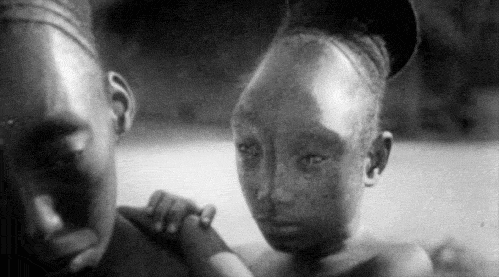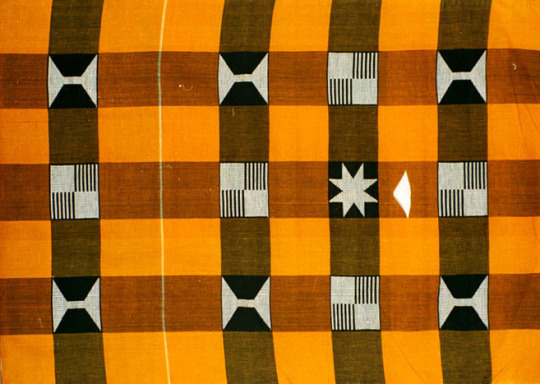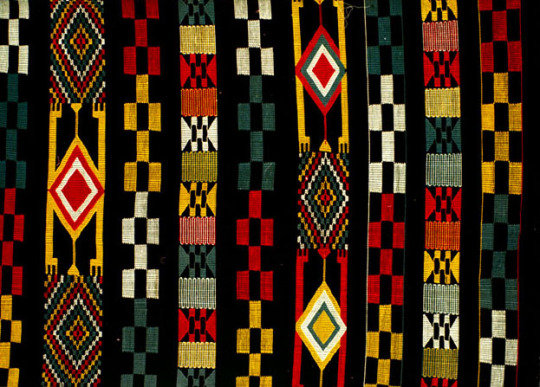A collection of random musings, articles, essays, images, obscure historical findings and the odd review, from a diasporic African perspective
Don't wanna be here? Send us removal request.
Photo


“At the 2005 African Literature Association Conference, Moyo Okediji gave a talk on shrine painting in Yoruba religious centers. One issue he challenged was the supposed universality of color theory. In color theory theorization white is the saturation of all color and black is the absence of color, which is exactly the opposite in the Yoruba theoretical model. Black is seen as the essence of all color, the beginnings of the color spectrum and white is seen as its absence. Yoruba shrine painters derive this theory from the nature of coal transmuting into fire. All colors are visible in the blaze of the fired coal and white arises from its ashy remains. This interpretation has dual significance. First, it challenges what is considered a fundamental universal concept in the creation of art, and second, it has profound implications for the sociolexical constructs of the terms black and white. Just from its aesthetic significance we can ask, How will color theorizing transform, if black becomes the normative standard from which all colors are produced? Since the binaries of Western logic rewrote color signification on the body of the black being, what will happen if black peoples revision themselves as the center of aesthetic representation, discourse and narrativizing ideals? How would this shift in color theory and its concentric representation sphers affect the psyche of the black subject and the lived reality of blackness?”
84 notes
·
View notes
Photo

3K notes
·
View notes
Photo




Textile patterns from the Igbo women’s weaving industry at Akwete, now in southern Abia State. National Library of the Netherlands, The Hague.
4K notes
·
View notes
Photo

According to Ashanti oral history, Adinkra – both the cloth and symbols, originated in the Akan kingdom of Gyaman (in present day Ivory Coast), and were brought to Kumasi when the king of Gyaman Nana Kofi Adinkra was captured after a battle with the Ashanti’s. He is said to have worn the cloth as a way of expressing his sadness of being taken as a captive to Kumasi. In precolonial times, Adinkra cloth was reserved for royalty who wore it on special occasions. It was worn mainly at funerals to express sadness and was typically made in the colours black (brisi), red (kobene) or dark brown (kuntunkuni) which symbolised mourning and death. It was also made using lighter cloth which was worn on festive occasions.
Ntonso, a town in the Ashanti region of Ghana is famed for being the historical home of Adinkra production, where it is still made in the traditional manner. The adinkra symbols represent important cultural values and knowledge that has been passed down for generations. Some of the many symbols include the popular ‘Gye Nyame’ meaning ‘Only God’ and ‘Sankofa’ meaning ‘go and get it’ which refers to the notion of learning from the lessons of the past.
Adinkra cloth is hand printed, traditionally onto locally woven cloth, though imported cloth is mostly used today. The traditional cloth was produced in strips, which were sewn together by hand to create large panels that were worn draped around the body.
Stamps were carved into adinkra designs from a calabash or gourd and then dipped into locally made dye, which was printed individually onto plain fabric. The dye used for the printing was made from the roots of the Kuntunkuni and the bark of the Badie tree which was pounded, boiled and mixed with iron-ore to produce a block of dark pigment that was then melted down for use as a dye. The cloth tends to be printed according to the instructions of the wearer, who may request specific symbols that are representative of a message they want to convey. Today, Adinkra is still an important part of Ashanti culture; and continues to be worn at funerals and festivities, which has helped to keep this tradition alive.
2 notes
·
View notes
Photo

Made by the Yoruba people of present day South-Western Nigeria, Adire is a resist-dye cloth that has been produced for centuries. It’s main production sites have traditionally been in Osogbo, Ibadan and Abeokuta. Thought to have come into production to preserve aspects of an older dying cloth, Adire is part of a long standing tradition of textile production in Africa. Adire was originally exclusively produced by women and was usually passed down from mother to daughter. Before the importation of factory made cotton cloth, local cotton was spun and woven into material, which was then bought for the use of making Adire. To obtain the dye, leaves from the indigo plant were collected, pounded and then treated with an alkaline solution, which helped to bring out the deep blue pigment.
There are three main varieties of Adire that are produced by using different techniques. For Adire Eleko, a paste was made from cassava, which was then drawn onto the material in designs that usually represented well known folklore or proverbs, and was then left to dry. For Adire Oniko, raffia was tied around small stones or pebbles to create a circular pattern, and stitching was used to create Adire Alabare. After the relevant technique was used, the material was dipped into the dye, which was contained in large clay pits. This process was overseen by a master dyer, a woman with several years of experience.
In earlier centuries it is thought that Adire was highly valued, and so was worn by wealthy members of society. However, by the 1960’s, perhaps due to the boom in production and increased availability, Adire began to be worn as a cloth for every day use.
Though the effects of colonisation drastically reduced the production of this material, Adire is still produced in much smaller quantities, by the few artisans who are keen to pass on this age old tradition.
Image: Victoria Scott
#indigenousclothseries#adire#africancloth#textiles#indigo#africa#history#nigeria#yoruba#africanfabric
1 note
·
View note
Photo

Prior to the introduction and popularisation of European wax printed cloth, (ankara) also known as 'African print', Africans throughout the continent had been producing a variety of cloths using indigenous methods. In many societies, the type of cloth worn represented status, wealth and position in the community. Specific cloths were used for certain occasions, and were often a central part of ceremonies and festivities. Towards the end of the 18th century, dutch traders began to flood the existing market with wax printed cloth, which was sold at a cheaper price and was therefore seen as more accessible than traditional fabrics. Many local makers couldn't compete with the new cloth, which was machine made and therefore produced in larger quantities. As well as this, the notion that European cloth was superior meant that wearing wax prints came to be a marker for high social status, which helped to cause a rapid decline in the use and production of indigenous cloths. Despite its popularity on the continent, as well as its use as a representation of African culture, the majority of wax printed fabric is still produced in Europe, with companies like Vlisco raking in millions every year. Today, sadly only a small percentage of indigenous fabrics are still made, and the few that continue to produce these cloths often struggle to make ends meet due to the lack of demand. This post will be the first in a series exploring fabrics made prior to colonisation.
1 note
·
View note
Photo

Produced for both decorative and monetary purposes, these anklets are thought to have been used as reserve wealth and were only exchanged for other goods in special circumstances or for items of a high value. They also signified a transfer wealth, and were given at events such as births, marriages and deaths. Similar anklets and bracelets were common amongst other ethnic groups across West and Central Africa, including the Igbo, Akan, Bamum and Yoruba.
2 notes
·
View notes
Text
An open Letter to the British Museum
On a recent trip to your museum, there were things that irked me and to be honest actually made me quite angry. You see, I am a history enthusiast, and have been as far back as I remember. So I was shocked to discover how scant the information and artefacts in your Africa section are. Last year, I was given the opportunity to do cross cultural training at your museum for a project I was working on. During the training, we were told by your staff that the artefacts on display are only a minute percentage of what you actually have in your archives. So where am I going with this? There are several points I would like to make. Firstly, I don’t understand why the Ancient Egypt section has been separated from the main Africa section. As far as I can see, most of your sections have been split up geographically. Now I understand that the later period in Egypt was heavily tied to Greece and Rome, and so it is understandable that you would choose to put artefacts from that time period in that section. However, it is quite baffling that not even one item from the earlier Egyptian period or anything from ancient Nubia was included in the Africa section? Why exactly is that? Are Egypt and Sudan not in Africa? What is even more confusing is that you have even managed to squeeze ancient Egyptian artefacts into your ‘European Enlightenment’ section, but still managed to evade connecting any of these items to the rest of Africa. It seems to me, that although you are a world renowned museum, you have still not managed to evolve past the age old notion that northern Africa is somehow historically excluded from the rest of the continent, or what many like to reduce to the title of ‘sub-Saharan’ Africa. Interestingly enough, you have even managed to include items from northern Africa after the Arab conquest but still nothing from ancient Nubia or Egypt. The second point I wanted to make was that there appeared to be three common themes in what you have included in the Africa section. Modern ‘African art’, War and Traditional African religion, which of course had to emphasise human and animal sacrifice. In isolation, these items are representative of the most prevalent stereotypes associated with Africa. In all the other parts of the museum, I managed to gain some sense of what life was like for the people who lived in that era - what they did, who they were, what games they played, how they built their houses, even what they wore. However, the way the Africa section has been constructed, is reminiscent of colonial accounts of barbaric people, who enjoyed killing humans as sacrifices to their gods and somehow also made valuable pieces of what they considered to be art. There was nothing that shows the ways of these people, there is no emphasis on their daily lives or who they were. This seems to be intentional, as a quick search through the museum’s online catalogue shows that there are items that can easily be used to paint a more honest and holistic picture. I also noticed that one of the main pieces in the Africa section, is the ‘Tree of life’, a piece of art made from pieces of guns which were used in the Mozambique civil war. Is this the only story about Africa that must be told? One of war and fighting? It is interesting that there is no mention of how items from all over the world came to be held in the British museum; perhaps it is sensible to say that a section should be dedicated to the history of colonialism during which these artefacts were obtained? This is the only section in which contemporary art, sits side by side with centuries old items and modern war memorabilia. In other words, the Africa section is a mishmash of items, that has haphazardly been thrown together and shows very little of the people that it claims to represent. A relevant equivalent would be the Europe section including not only prehistoric or Anglo Saxon artefacts, but also a random contemporary art installation made of shrapnel from World War II and planes that were used to drop bombs on Iraq, a bizarre mix considering that this is not the tone of the rest of the museum. It seems that there is a blasé attitude towards what the chosen items convey or how they are further perpetuating negative stereotypes. In conclusion, I don’t expect you to care, after all, your very existence is part of a legacy of conquest and imperialism. However, I would like to say, that the way that you have chosen to portray Africa, through the items on display, the omittance of whole geographical areas and lack of historical context of much of the information you present, is testament to the fact that you are a just another institution dedicated to maintaining widespread misinformation and upholding the dehumanisation of a whole continent of people.
1 note
·
View note
Text
Some thoughts on Development in African Architecture
A few days ago I was at Africa Utopia in the South Bank centre. I’d been looking forward to this event for weeks and really wanted to hear the discussion on African architecture. Three architects were on the panel, including two women, which I found interesting. One was from Ghana; the other Zimbabwe and there was also a Portuguese architect, who is currently doing a research project in Angola. Some good points were raised in the talk, mostly by the Zimbabwean architect. One of the things she mentioned was that most of the buildings being built across the continent are structured on a Western model, which is inconsiderate of both the environment and the people, as it doesn’t reflect their way of life.
What I found the most memorable was the talk about James Town, a coastal area in Accra, where the Ghanaian architect has been working on regeneration. Amongst many things, she mentioned that they (a collective of Ghanaian Architects) want to renovate the old colonial buildings; to encourage local artists to create studios and develop something similar to London’s Shoreditch.
At first glance these proposals may seem great, however I need to ask why in a conversation about an African city, Shoreditch is being used as the model for development. As my friend rightly pointed out, In Ghana, artisans typically work in an open space. Why then do we feel that just because artists in Europe or America work in studios, that same concept applies to a carver or painter in Accra? Why not create something new that will encourage a productive environment for outdoor work?
It got me thinking about development in Africa. What does it mean to be a developed nation or continent? Is it when we have skyscrapers like New York and shopping centres that can compete with any in Europe? Who defines development? For the most part, global development has been explored through a biased Eurocentric lens, meaning that in many areas including architecture, traditional methods are are continuously neglected and overlooked.
What I am increasingly sensing from discussions on African development, is the desire to create duplicates of western cities on the continent. To many Africans across the diaspora, the fact that there are high rise flats and skyscrapers signifies the dawn of a ‘New Africa’. However to others like myself, it represents the destructive effects of globalisation and the success of cultural imperialism. There is no doubt that an overcrowded area like James Town needs to be redeveloped, however the solution is not to impose the western style of architecture as the sole form of development. Exploring traditional ways of building and living will enable architects to create efficient structures that are both harmonious with the surroundings and considerate of the way people live.
I’m no expert, but I know that in order to be beneficial, development on the continent must be defined and implemented by Africans who live in and experience their environment. If there is to be a ‘New Africa’ I imagine it to be a place where we have finally been able to overcome this pervasive notion that development only equates to what we see in the west. I think that we need to be able to embrace our difference, and use our creativity, history and culture as the basis for true development.
2 notes
·
View notes